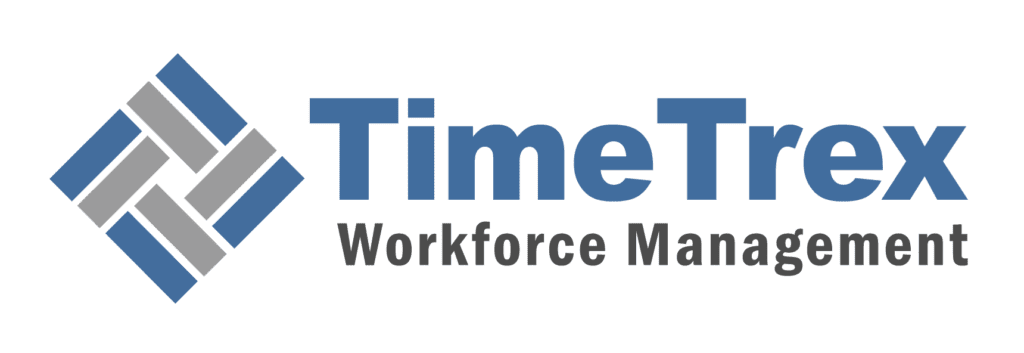The Best Employee Scheduling Software Apps
By The TimeTrex Editorial Team on August 28, 2025
Our reviewers evaluate software independently. As the creators of TimeTrex, we have a deep understanding of the workforce management landscape. This guide reflects our expert analysis of the market, designed to help you find the best solution for your business.
QUICK SUMMARY
Tired of spreadsheets, scheduling conflicts, and payroll errors? The best employee scheduling software automates shift planning, streamlines communication, and ensures compliance. This guide reviews the top 10 scheduling apps and workforce management solutions that take the stress out of your day, helping you build efficient, cost-effective schedules with ease.
Best Employee Scheduling Software Shortlist
Here is my pick of the 10 best scheduling software tools reviewed in this guide.
- TimeTrex — Best all-in-one with native payroll & compliance.
- Deputy — Best for AI-powered demand forecasting.
- Connecteam — Best for mobile-first, deskless workforces.
- Homebase — Best for single-location small businesses.
- 7shifts — Best for the restaurant industry.
- When I Work — Best for ease of use and team communication.
- Sling — Best free plan for startups.
- ZoomShift — Best for simple and affordable scaling.
- Rippling — Best for a unified HR/IT/Finance platform.
- Shiftboard — Best for complex, regulated industries.
The right employee scheduling software is no longer a luxury; it's a necessity for operational excellence. If you're still wrestling with spreadsheets to manage shift scheduling, constantly putting out fires from last-minute changes, or losing sleep over complex labor laws, you're losing valuable time and money. Manual methods are a direct path to higher labor costs, compliance violations, and frustrated employees.
Modern scheduling apps and integrated workforce management platforms solve these problems. They provide a central hub for everything from creating schedules and tracking time to communicating with your team and even processing payroll. As an organization with over 20 years of experience developing workforce management software, we’ve analyzed the entire market to identify which solutions deliver real value. This in-depth guide will walk you through the top shift scheduling tools designed for the unique challenges US businesses face.
Why Trust Our Software Reviews
We've been at the forefront of the workforce management industry since 2003. As HR and payroll technology professionals ourselves, we understand how critical it is to choose the right software. We invest in deep research to help our audience make better decisions. This review is the culmination of extensive market analysis, competitor benchmarking, and a deep understanding of the features that truly matter for efficiency, compliance, and profitability.
Best Employee Scheduling Software: Comparison Chart
| Tool | Best For | Payroll | Free Plan | Starting Price (Paid) |
|---|---|---|---|---|
| 1. TimeTrex | Integrated Payroll & Compliance | Native | Yes (Full-featured) | ~$5/user/mo |
| 2. Deputy | AI-Powered Forecasting | Integration | Yes (100 shifts/month) | ~$6.00/user/mo |
| 3. Connecteam | Mobile-First, Deskless Teams | Integration | Yes (10 users) | ~$29/mo (30 users) |
| 4. Homebase | Single-Location Small Business | Add-on | Yes (1 loc, 20 users) | ~$24/loc/mo |
| 5. 7shifts | Restaurants | Add-on | Yes (1 loc, 15 users) | ~$39.99/loc/mo |
| 6. When I Work | Ease of Use | Integration | No (14-day trial) | ~$2.50/user/mo |
| 7. Sling | Startups & Free Plan Value | Integration | Yes (30 users) | ~$1.70/user/mo |
| 8. ZoomShift | Simplicity & Affordability | Integration | Yes (20 users) | ~$2/user/mo |
| 9. Rippling | Unified HR/IT/Finance | Native | No | Quote-Based |
| 10. Shiftboard | Complex, Regulated Industries | Integration | No | Quote-Based |
The 10 Best Employee Scheduling Software Reviews
1. TimeTrex — Best All-in-One with Native Payroll & Compliance
Free plan available | From ~$5/user/month
Rating: 4.9/5
See Custom Pricing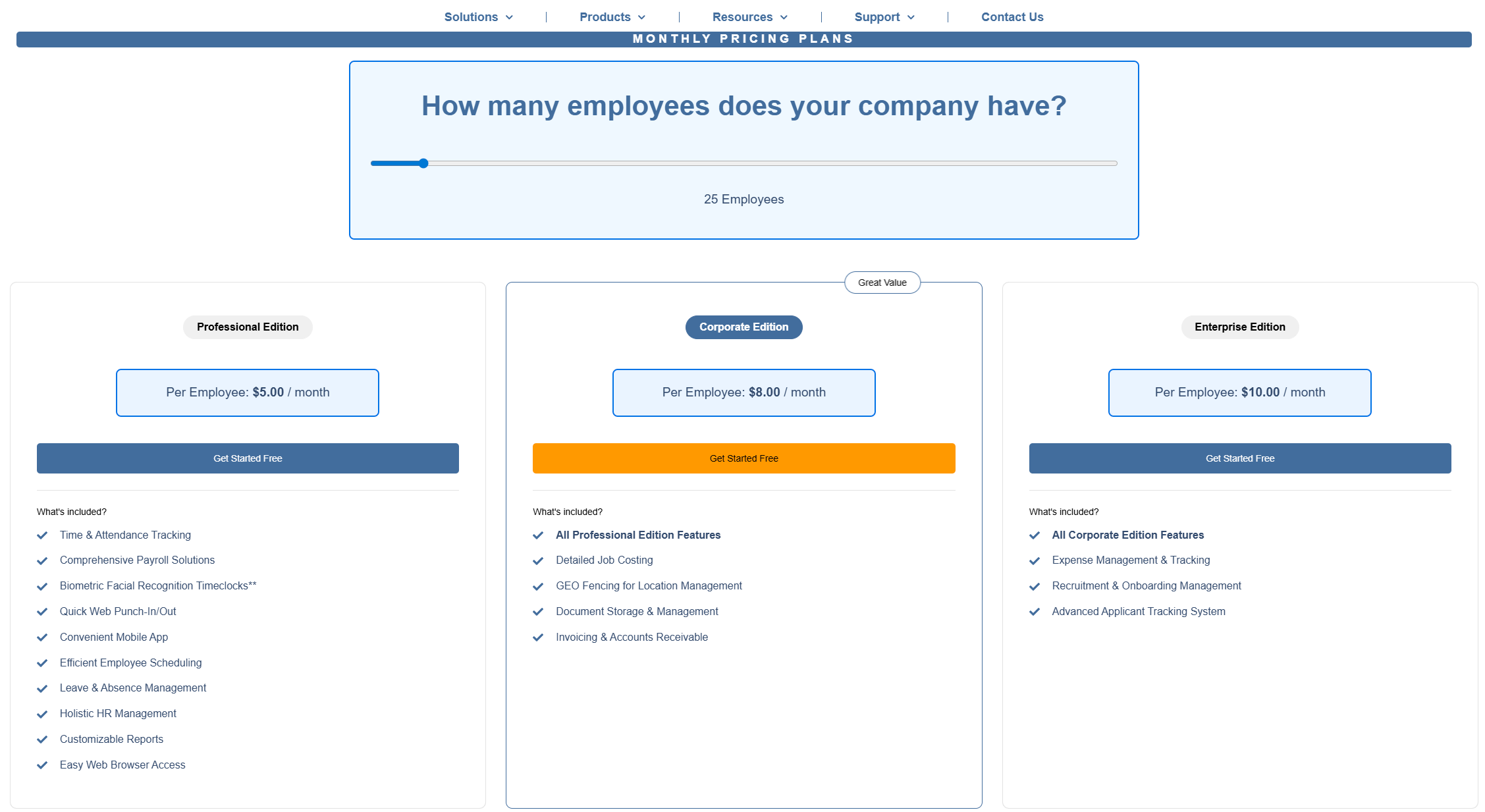 Why I picked TimeTrex:
Why I picked TimeTrex:
I picked TimeTrex as the number one solution because it solves the biggest pain point for most businesses: the disconnect between scheduling and payroll. While many competitors offer integrations, TimeTrex has a fully native payroll engine. This means shift scheduling data, time and attendance tracking, overtime, and leave all flow seamlessly into payroll calculations without any manual exporting or risk of errors. For businesses in the US and Canada with complex labor laws, this native, all-in-one architecture is the gold standard for compliance and efficiency in any workforce management software.
TimeTrex Standout Features and Integrations:Features include a powerful rule-based scheduling engine for complex rotations, employee self-service for availability and leave requests, biometric facial recognition timeclocks (using any tablet/phone), geofencing with GPS tracking, and a comprehensive HR module (HRM) for tracking qualifications and performance reviews. The native payroll handles all federal/state/local taxes, deductions, and direct deposits automatically. Job costing features also allow for precise tracking of labor costs against projects.
What's Free:TimeTrex's free Community Edition is a game-changer. Unlike competitors' limited free tiers, it provides enterprise-grade scheduling software, time and attendance, AND full payroll processing for free. This makes it an incredibly powerful and accessible option for small businesses and non-profits.
Potential Drawbacks:Its strength is its rules-based engine, so it lacks the predictive AI forecasting found in platforms like Deputy.
2. Deputy — Best for AI-Powered Demand Forecasting
31-day trial | From ~$6.00/user/month
Rating: 4.6/5
Visit Website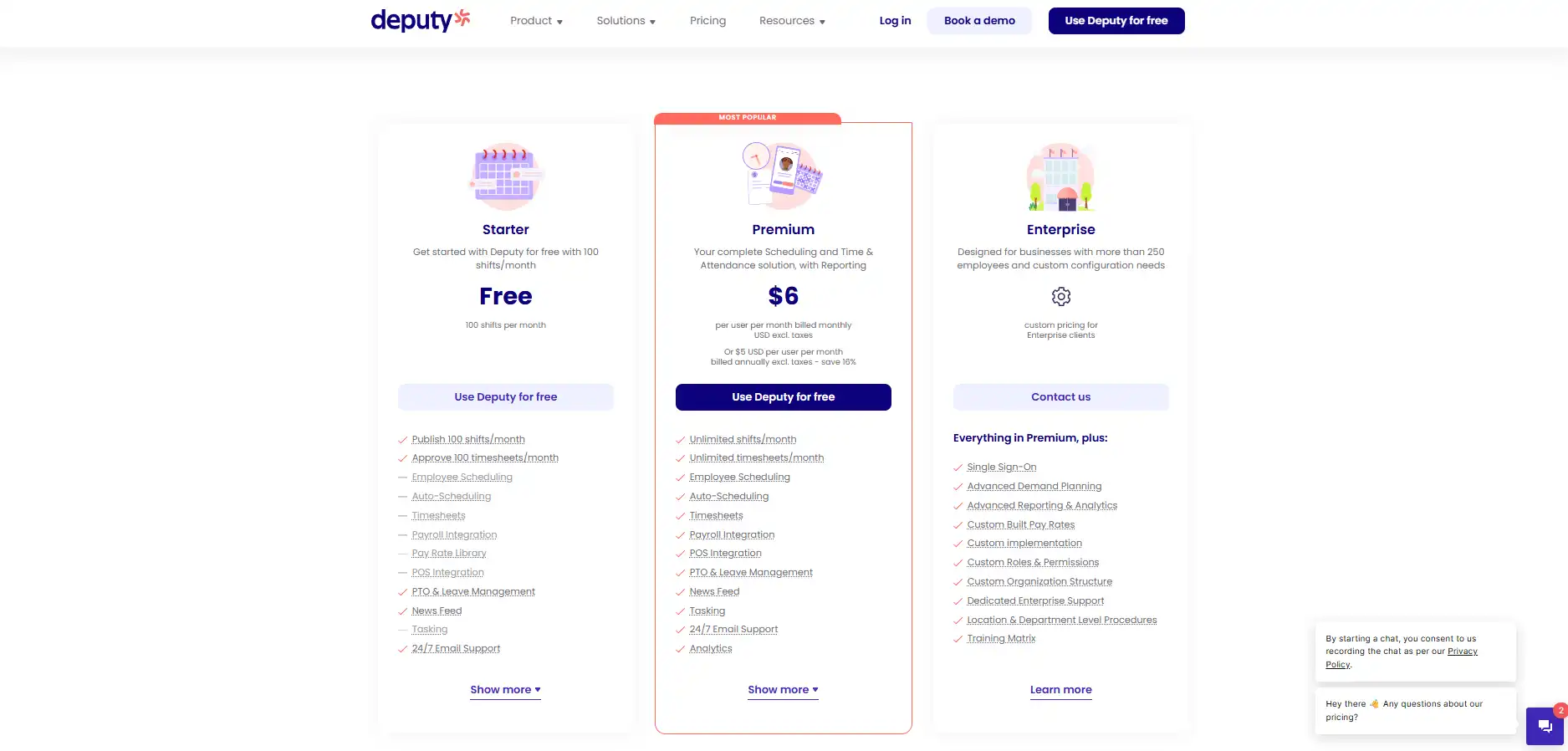 Why I picked Deputy:
Why I picked Deputy:
I picked Deputy because it's the clear leader for businesses where labor cost optimization is the top priority. Its AI engine is exceptional at analyzing demand signals like sales data, foot traffic, or even weather forecasts to create the most efficient schedule possible with a single click. If your primary goal is to perfectly match staffing levels to fluctuating business demand, Deputy's predictive auto-scheduling is the most advanced tool on the market.
Deputy Standout Features and Integrations:Features include AI-powered auto-scheduling, highly-rated mobile apps with biometric clock-in, strong compliance tools for meal/rest breaks, and a built-in "Newsfeed" for team communication. Integrations are a key strength, with connections to hundreds of POS, payroll, and HR systems like Square, ADP, and Gusto.
Potential Drawbacks:Deputy lacks a native payroll module, relying entirely on third-party integrations. Its per-user pricing can also become expensive for businesses with a large number of part-time employees.
3. Connecteam — Best for Mobile-First, Deskless Workforces
Free plan available | From ~$29/month for 30 users
Rating: 4.8/5
Visit Website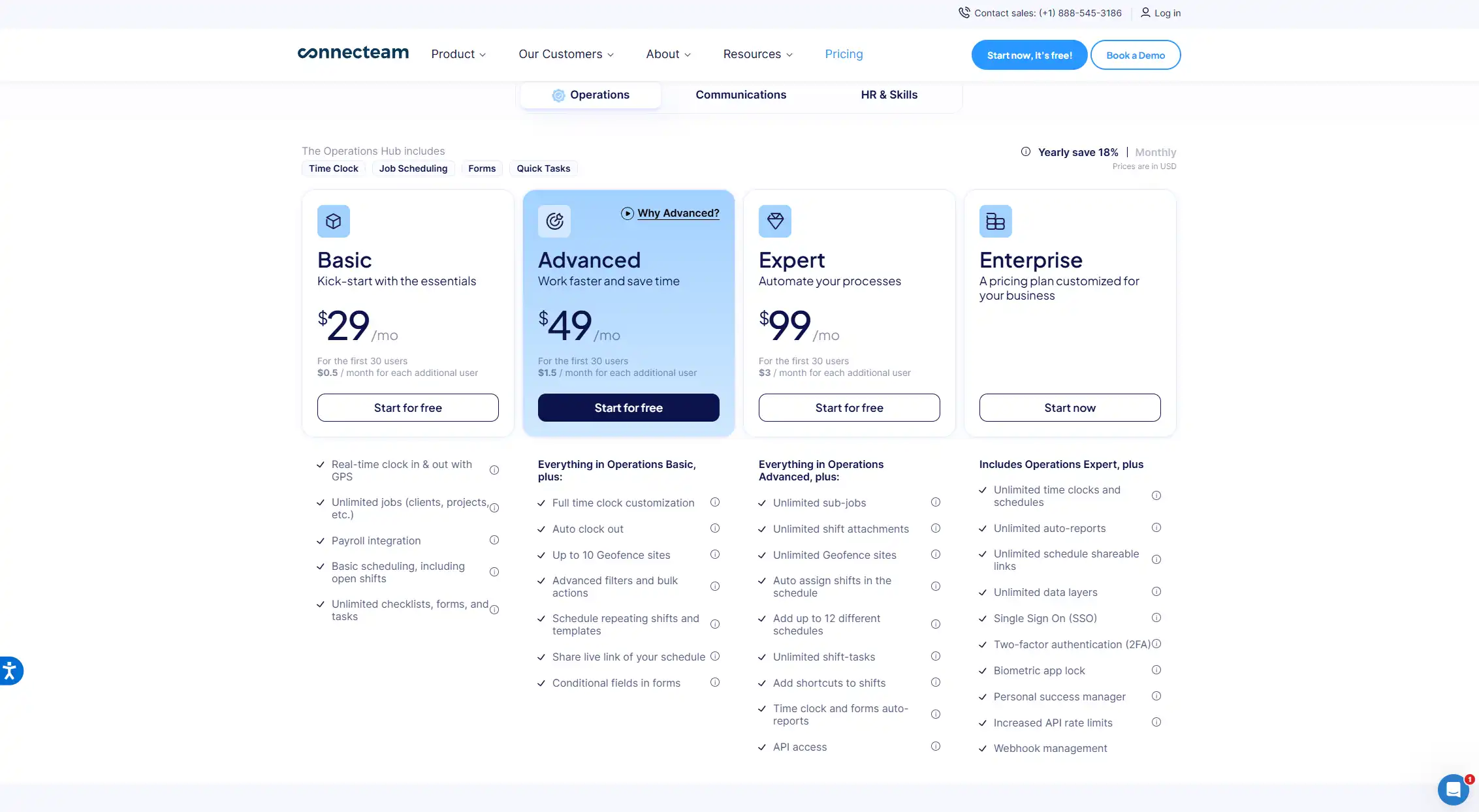 Why I picked Connecteam:
Why I picked Connecteam:
Connecteam made my list because it is built from the ground up for the deskless workforce. Its mobile scheduling app is arguably the best in the category, combining scheduling, time tracking, task management, digital forms, and robust communication tools into one intuitive interface. For industries like field services, construction, or security, where everything happens on a smartphone, Connecteam's mobile-centric design is unbeatable.
Connecteam Standout Features and Integrations:Features include an exceptional mobile experience, advanced GPS tracking with geofencing and "breadcrumbs" live location, in-app chat and newsfeed, digital forms and checklists, and a new AI scheduling assistant. Integrations are available for popular payroll providers like QuickBooks and Gusto.
What's Free:Connecteam offers a generous free-forever plan for small businesses with up to 10 users, making it a great entry point for mobile teams.
Potential Drawbacks:The platform has no native payroll. Its hub-based pricing can become complex and costly if you need features from all three of its "Hubs" (Operations, Communications, and HR).
4. Homebase — Best for Single-Location Small Businesses
Free plan available | From ~$24/location/month
Rating: 4.5/5
Visit Website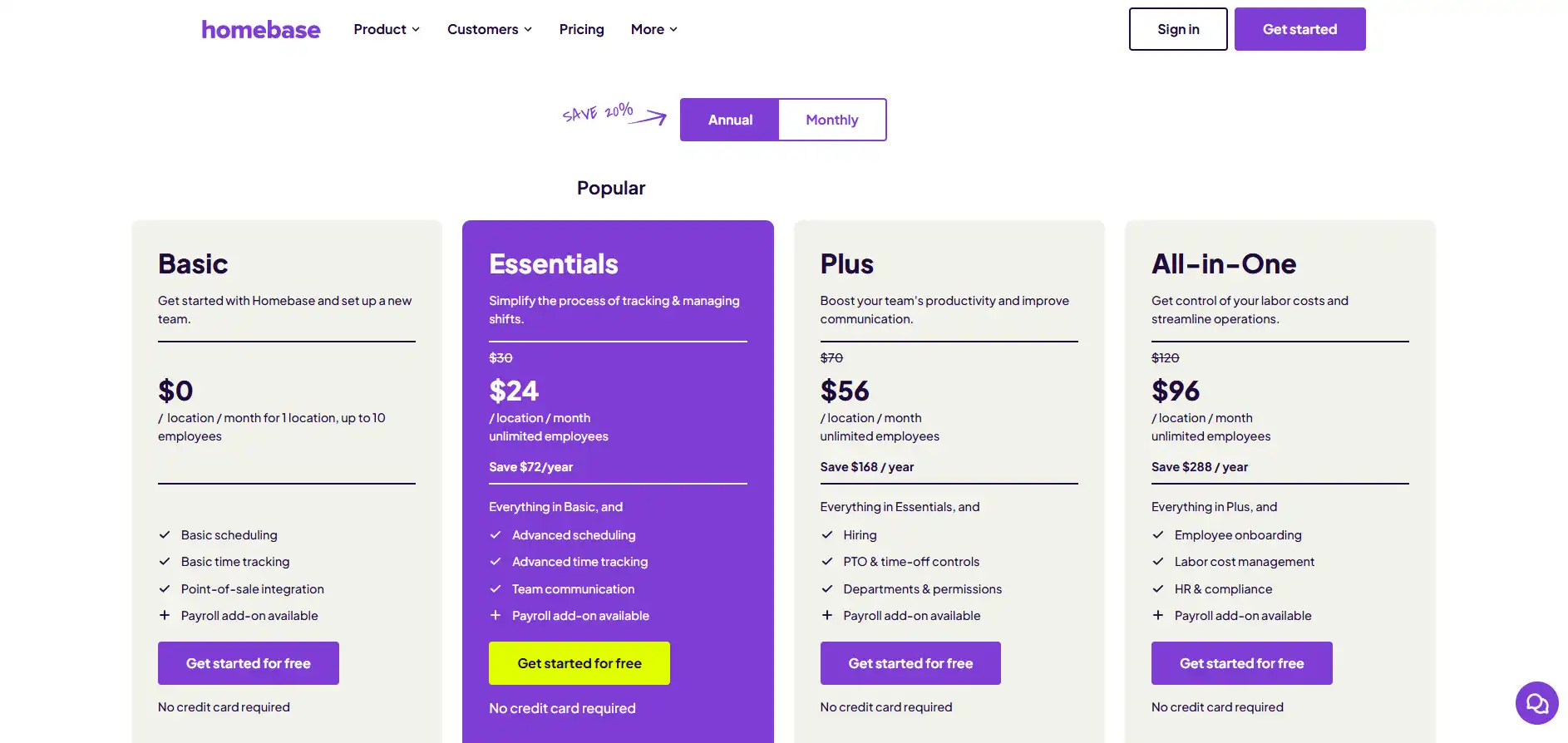 Why I picked Homebase:
Why I picked Homebase:
Homebase is my top pick for the classic main street small business—the local coffee shop, boutique, or restaurant. Its per-location pricing model is incredibly cost-effective for a single site with many employees. It combines employee scheduling, time tracking, team messaging, and even hiring tools into a very easy-to-use package, making it a fantastic all-in-one small business scheduling solution.
Homebase Standout Features and Integrations:Features include a strong free plan for one location, an all-in-one toolkit with scheduling and hiring, an AI "Scheduling Assistant," and the ability to turn any device into a time clock kiosk. Integrations with leading POS systems are a major strength.
What's Free:Homebase is free for unlimited employees at one location, a fantastic value proposition for small businesses.
Potential Drawbacks:The per-location pricing becomes much less competitive for multi-location businesses. The integrated payroll is a separate, costly add-on, which can be misleading.
5. 7shifts — Best for the Restaurant Industry
Free plan available | From ~$39.99/location/month
Rating: 4.7/5
Visit Website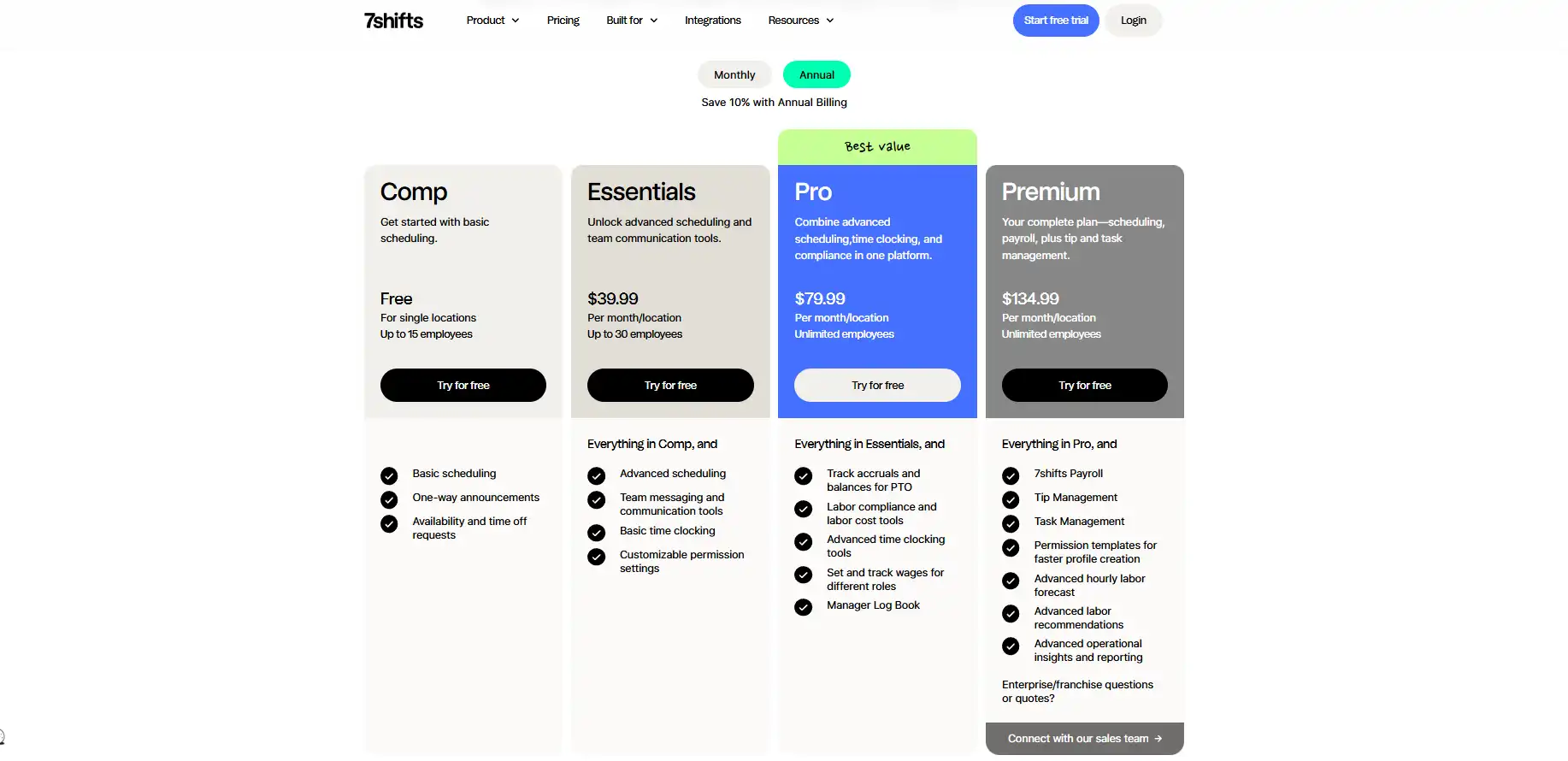 Why I picked 7shifts:
Why I picked 7shifts:
I chose 7shifts because it is, without a doubt, the best purpose-built scheduling tool for restaurants. Every feature is designed to solve a specific problem in the food and beverage industry. Its ability to integrate directly with restaurant POS systems to pull sales data for labor forecasting is a standout capability. For any restaurant, bar, or cafe, 7shifts understands your unique workflow better than any general-purpose scheduler.
7shifts Standout Features and Integrations:Features include deep POS integration for labor vs. sales analysis, robust tools for tip pooling and distribution, a manager logbook for shift handovers, and strong compliance features for meal and rest breaks. Integrations with systems like Toast, Square, and Lightspeed are its core strength.
What's Free:7shifts offers a free "Comp" plan for a single location with up to 20 employees.
Potential Drawbacks:Its time tracking function requires a separate "7punches" mobile app, which can be inconvenient for staff. Its specialization makes it a poor fit for non-restaurant businesses.
6. When I Work — Best for Ease of Use and Team Communication
14-day trial | From ~$2.50/user/month
Rating: 4.4/5
Visit Website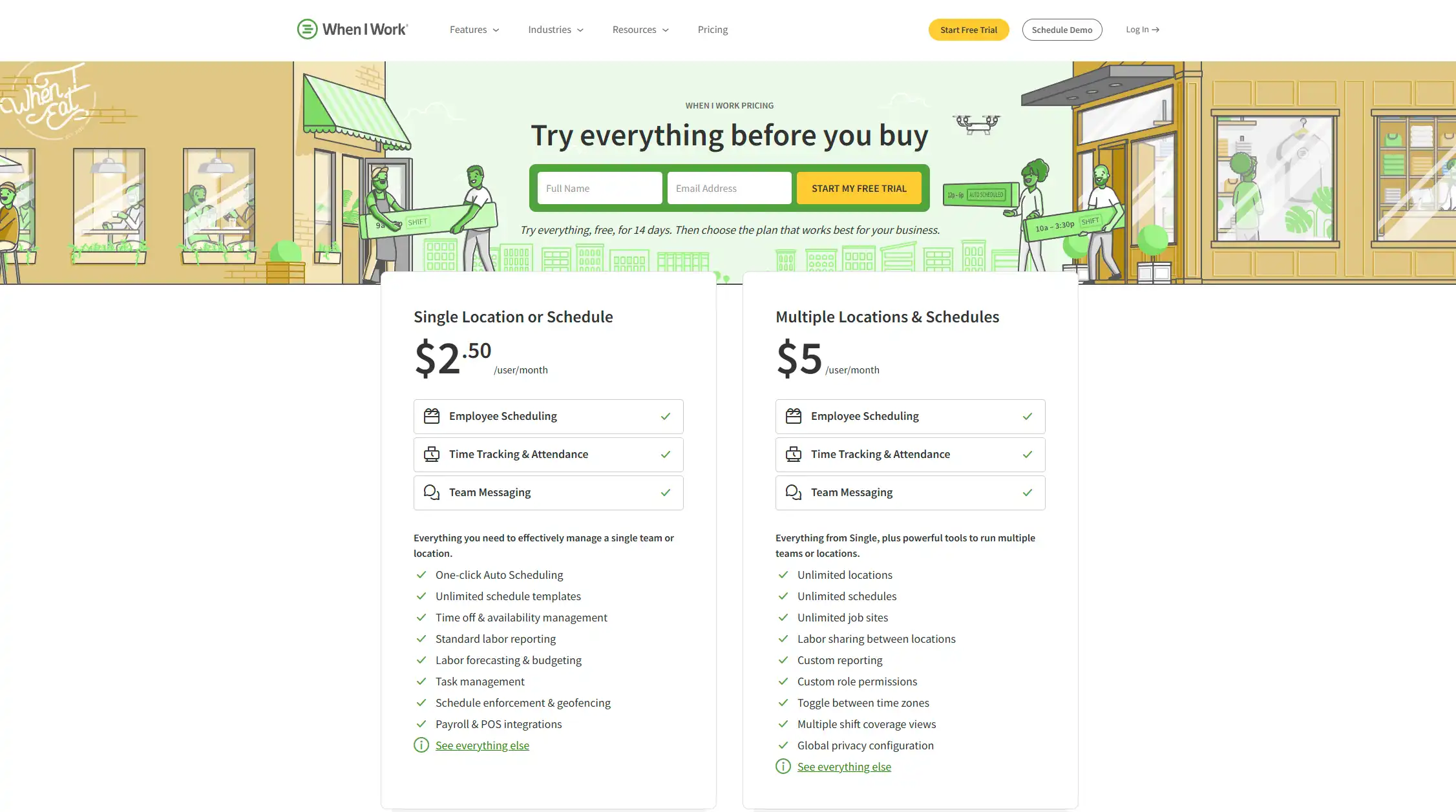 Why I picked When I Work:
Why I picked When I Work:
When I Work is my pick for businesses that prioritize simplicity above all else. Its interface is incredibly intuitive and clean, making it one of the easiest scheduling apps to learn and use. It excels at the fundamentals: building schedules quickly and facilitating team communication through its excellent "WorkChat" feature, which reduces the need for external messaging apps.
Standout Features:Features include a simple drag-and-drop schedule builder, an "Auto Assign" feature for open shifts, integrated one-on-one and group chat, and strong tools for employee-initiated shift swaps.
Potential Drawbacks:Lacks advanced labor forecasting and budgeting tools. Some user reviews mention occasional bugs and performance issues with the mobile app, particularly on Android.
7. Sling — Best Free Plan for Startups
Free plan available | From ~$1.70/user/month
Rating: 4.6/5
Visit Website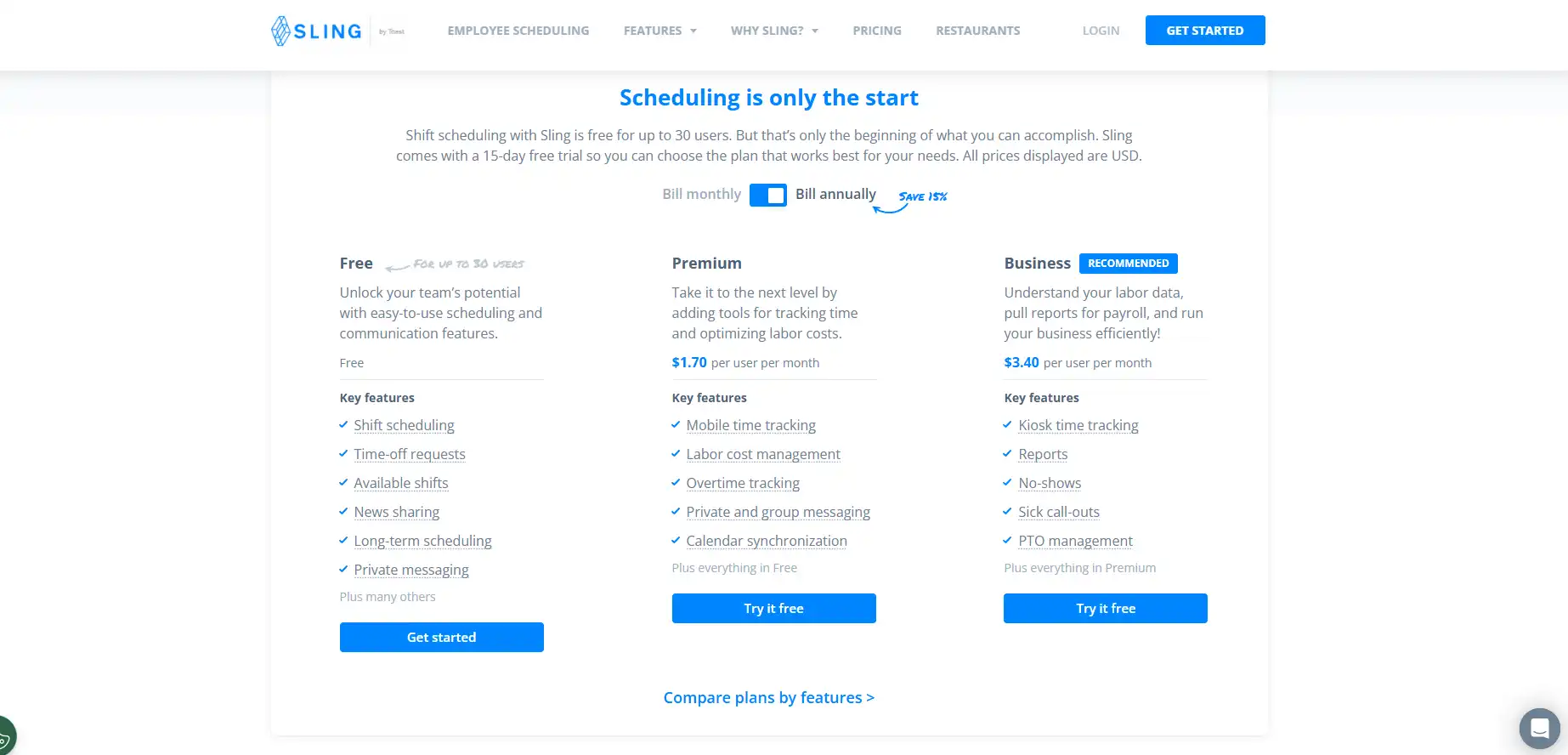 Why I picked Sling:
Why I picked Sling:
Sling stands out for its remarkably powerful free plan. For startups, non-profits, or any small business on a tight budget, Sling provides unlimited scheduling for up to 30 users at no cost. This isn't just a trial; it's a genuinely useful free scheduling software that covers the core needs of many small teams, making it an unbeatable entry point.
Standout Features:The free plan includes unlimited scheduling, time-off requests, and a newsfeed for announcements. Paid plans add valuable features like mobile time tracking with geofencing, labor cost management, and task management capabilities.
What's Free:Sling's free-forever plan supports scheduling for up to 30 users.
Potential Drawbacks:Key features such as reporting and integrations are locked behind the most expensive plan. The number of third-party integrations is more limited compared to larger competitors.
8. ZoomShift — Best for Simplicity and Affordable Scaling
Free plan available | From ~$2/user/month
Rating: 4.5/5
Visit Website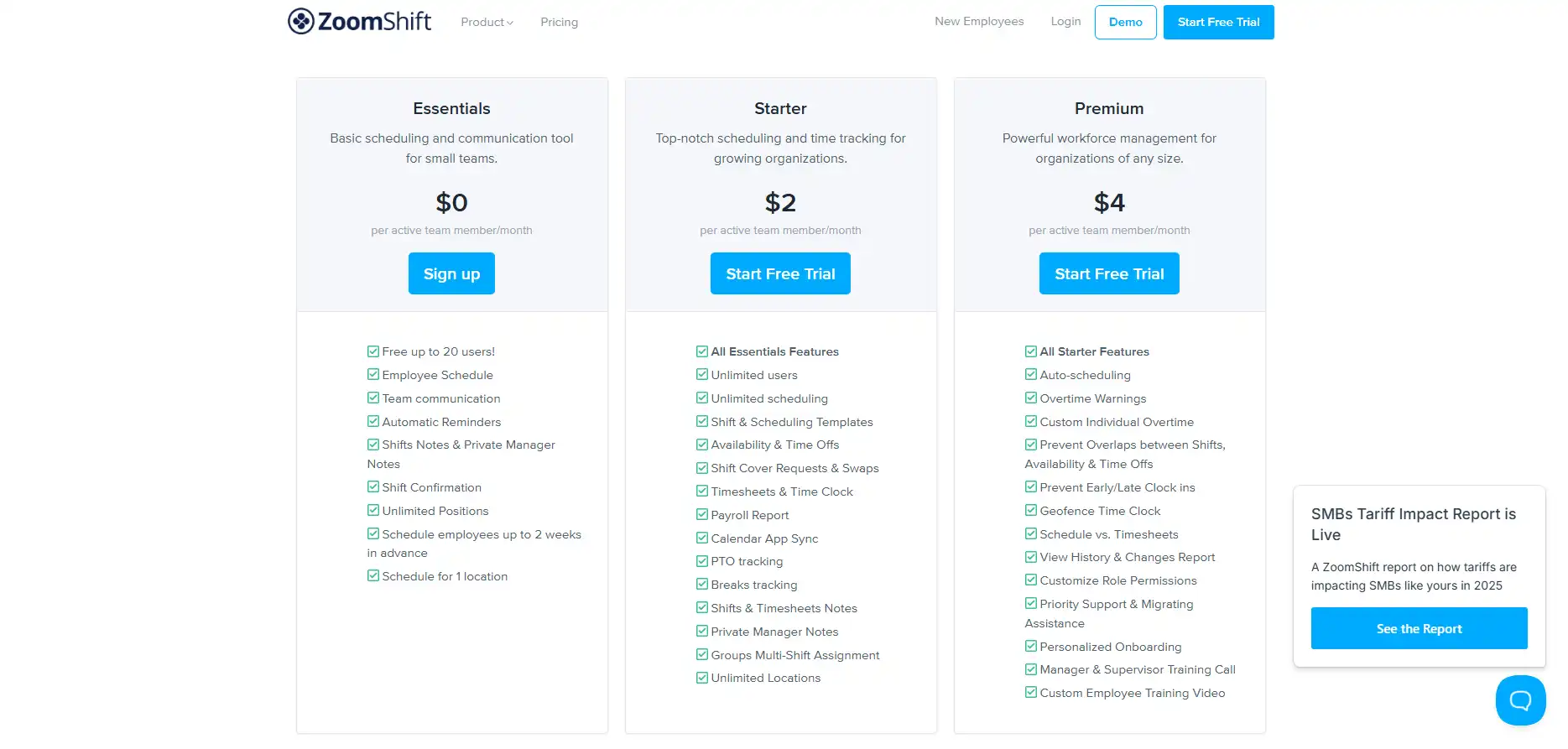 Why I picked ZoomShift:
Why I picked ZoomShift:
ZoomShift is the ideal choice for businesses that have outgrown spreadsheets but aren't ready for a complex, enterprise-level workforce management system. It focuses on doing the basics—scheduling and time tracking—exceptionally well. Its clean interface and highly affordable per-user pricing make it a fantastic, budget-friendly option for teams that are scaling up.
Standout Features:Features include a user-friendly drag-and-drop schedule builder, reusable templates, well-regarded mobile apps for iOS and Android, and tools to prevent early clock-ins.
What's Free:ZoomShift offers a free "Essentials" plan for up to 20 users.
Potential Drawbacks:It lacks advanced features like biometrics, deep compliance tools, or AI forecasting. Its communication tools are also less robust than competitors like Connecteam.
9. Rippling — Best for a Fully Integrated HR, IT, and Finance Ecosystem
Quote-Based Pricing
Rating: 4.4/5
Visit Website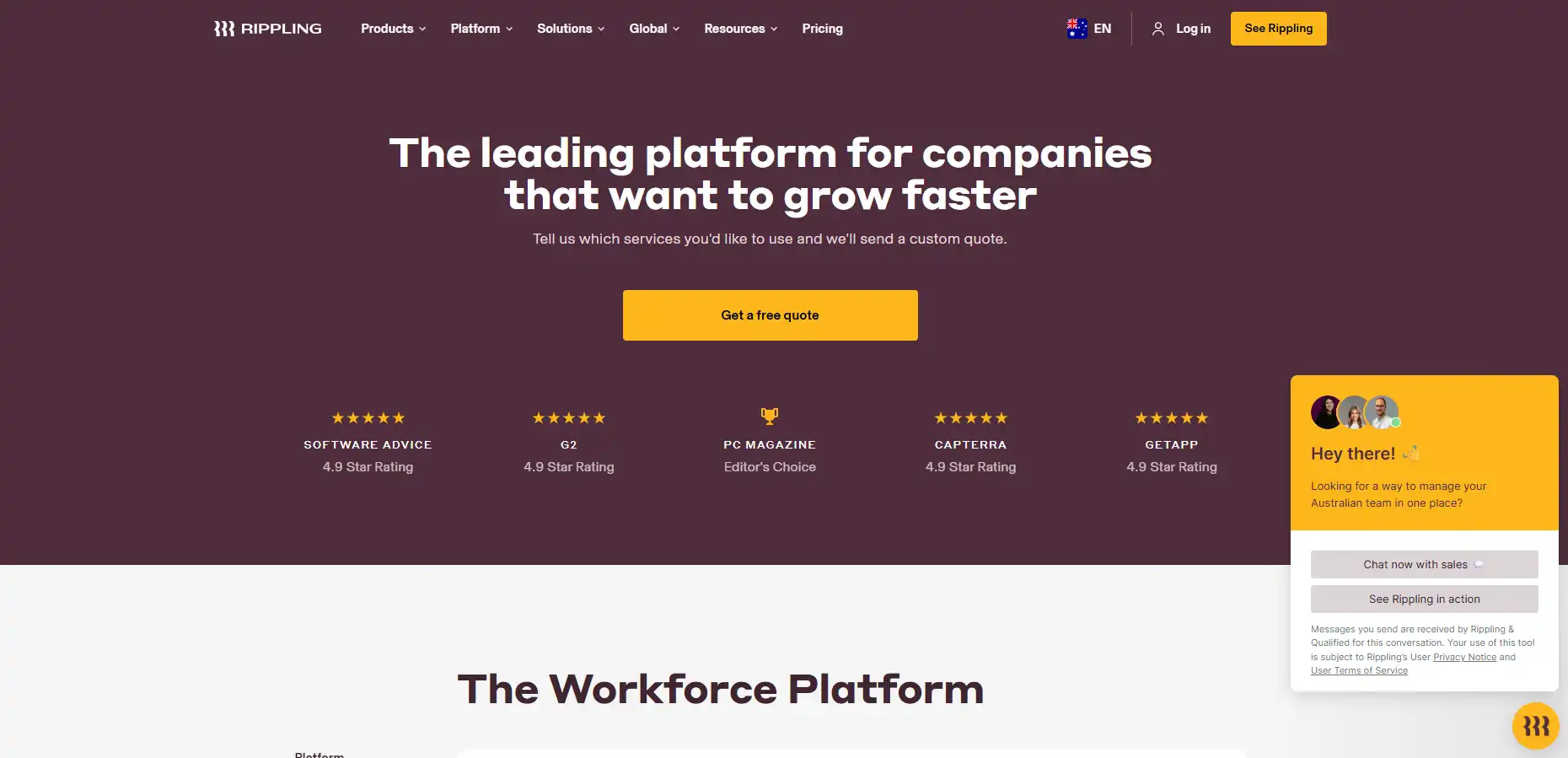 Why I picked Rippling:
Why I picked Rippling:
Rippling is more than just a scheduling app; it's a unified "Workforce Management Platform" that aims to be the central nervous system for a company's HR, IT, and Finance operations. I picked it for tech-forward, high-growth companies that need to manage the entire employee lifecycle—from onboarding and IT device provisioning to global payroll and offboarding—all from a single source of truth.
Standout Features:Its core strength is the unified employee database. The "Workflow Studio" enables powerful cross-system automations (e.g., automatically provisioning a new hire with a laptop and software licenses). It also offers native global payroll and benefits administration.
Potential Drawbacks:The platform's complexity and premium price make it overkill for small businesses that only need scheduling. Its mobile app has lower user ratings than dedicated scheduling apps.
10. Shiftboard — Best for Complex, Mission-Critical Scheduling in Regulated Industries
Quote-Based Pricing
Rating: 4.3/5
Visit Website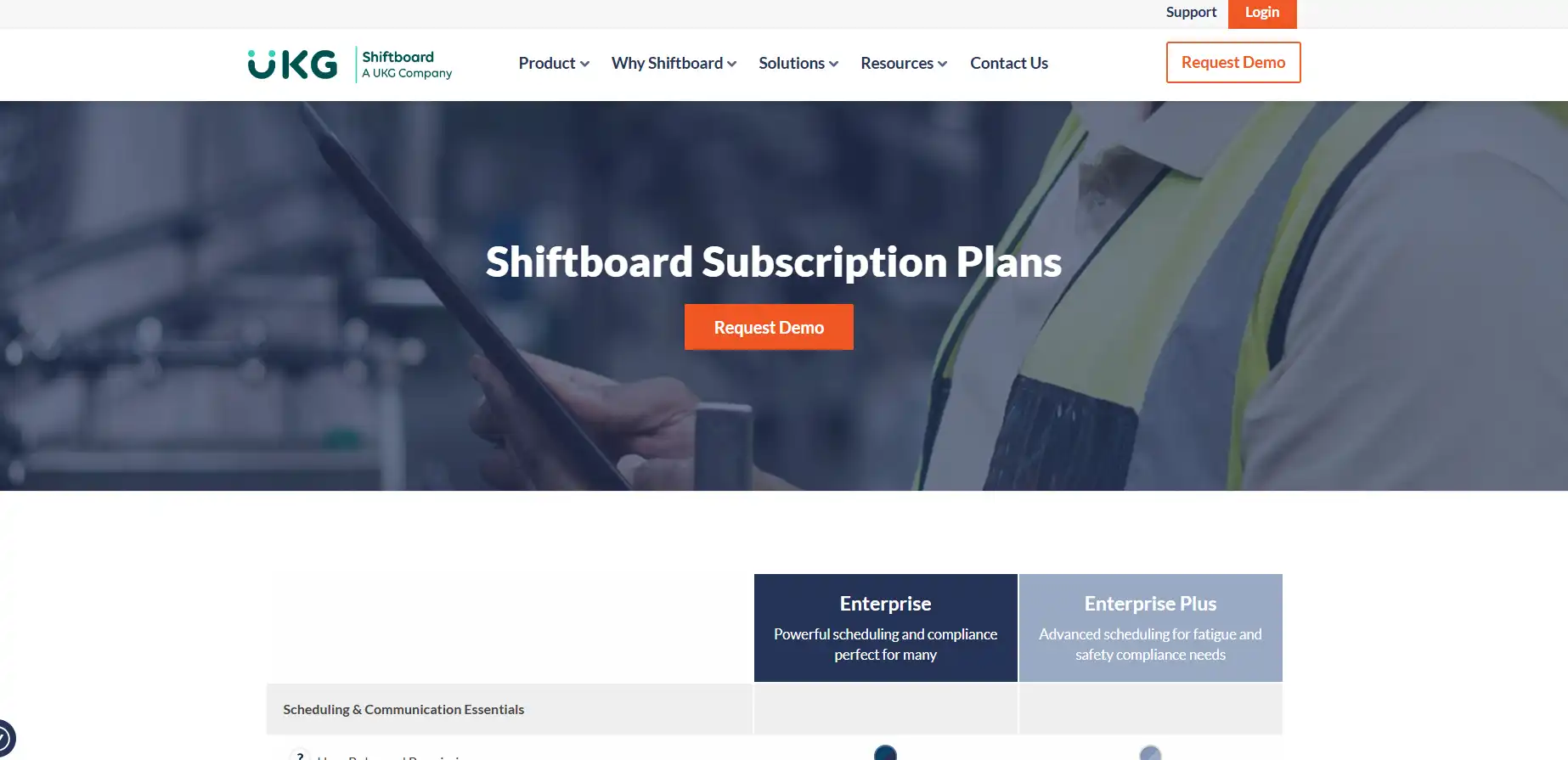 Why I picked Shiftboard:
Why I picked Shiftboard:
Shiftboard is an enterprise-grade solution built for the most complex scheduling environments imaginable. I chose it for industries like manufacturing, energy, and public safety where scheduling is mission-critical and governed by intricate union rules and strict safety regulations. Its powerful automation engine is designed to handle these high-stakes compliance challenges.
Standout Features:Features a highly configurable schedule automation engine for complex union agreements and government regulations, specialized tools for fair overtime distribution, and robust compliance features for fatigue management and employee certifications.
Potential Drawbacks:The user interface is often described as outdated and clunky. It is significantly more expensive and complex than what most small or medium-sized businesses would ever need.
How to Choose the Best Employee Scheduling Software for Your Business
Finding the right shift scheduling software requires a careful look at your own operations. Before choosing, ask yourself these key questions:
- What is our biggest scheduling pain point? Is it avoiding overtime, managing last-minute call-outs, ensuring compliance with break laws, or simply saving administrative time? Define your primary problem to find a tool that solves it.
- How important is payroll integration? If eliminating manual data entry for payroll is a top priority, a system with native payroll like TimeTrex or Rippling is crucial. If you have a payroll provider you like, a tool with strong integrations like Deputy will work.
- Is our workforce desk-based or deskless? For teams in the field, a best-in-class mobile scheduling app is non-negotiable. Test the mobile experience of platforms like Connecteam and Deputy thoroughly.
- What is our budget structure? A per-location model (Homebase, 7shifts) is great for single sites with many employees. A per-user model (Deputy, TimeTrex) is better for multi-location businesses or companies with a stable, full-time workforce.
Frequently Asked Questions on Employee Scheduling Software
What is employee scheduling software?
Employee scheduling software is a tool that helps managers create, manage, and share work schedules with their teams. It replaces manual methods like spreadsheets and paper calendars, automating tasks like shift assignments, tracking employee availability, and managing time-off requests. Advanced platforms, often called workforce management software, also include features for time and attendance, communication, labor law compliance, and payroll.
How does auto-scheduling work?
Auto-scheduling uses algorithms to automatically create a schedule. There are two main types: rules-based (like in TimeTrex), which fills shifts based on pre-set rules like employee availability, qualifications, and overtime limits; and AI-predictive (like in Deputy), which analyzes historical data (like sales or foot traffic) to forecast staffing needs and build the most cost-effective schedule.
What's the difference between native payroll and a payroll integration?
A payroll integration means the scheduling software can send timesheet data to a separate, third-party payroll provider (like ADP or Gusto). This is convenient, but still requires managing two systems and risks data sync errors. Native payroll, found in platforms like TimeTrex, means the payroll processing engine is built into the same system as scheduling and time tracking. This creates a single source of truth, eliminating data exports and dramatically improving accuracy and efficiency.
How can a scheduling app help with labor law compliance?
Modern scheduling apps have built-in compliance tools. They can automatically track and enforce rules for meal and rest breaks, alert managers before an employee goes into overtime, and ensure compliance with "Fair Workweek" or predictive scheduling laws by tracking schedule changes. This significantly reduces the risk of costly legal violations.
Disclaimer: The content provided on this webpage is for informational purposes only and is not intended to be a substitute for professional advice. While we strive to ensure the accuracy and timeliness of the information presented here, the details may change over time or vary in different jurisdictions. Therefore, we do not guarantee the completeness, reliability, or absolute accuracy of this information. The information on this page should not be used as a basis for making legal, financial, or any other key decisions. We strongly advise consulting with a qualified professional or expert in the relevant field for specific advice, guidance, or services. By using this webpage, you acknowledge that the information is offered “as is” and that we are not liable for any errors, omissions, or inaccuracies in the content, nor for any actions taken based on the information provided. We shall not be held liable for any direct, indirect, incidental, consequential, or punitive damages arising out of your access to, use of, or reliance on any content on this page.
Time To Clock-In
Start your 30-day free trial!
Experience the Ultimate Workforce Solution and Revolutionize Your Business Today
- Eliminate Errors
- Simple & Easy To Use
- Real-time Reporting
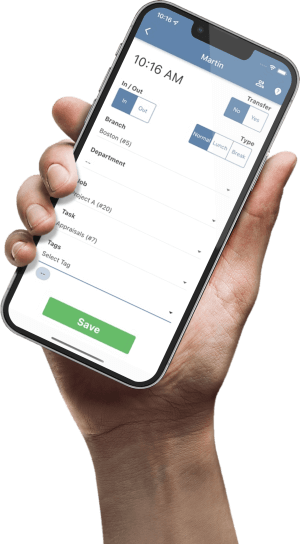
Saving businesses time and money through better workforce management since 2003.
Copyright © 2025 TimeTrex. All Rights Reserved.
